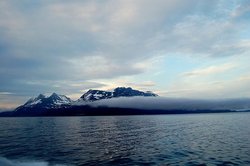Principles of Conserving the Arctic’s Biodiversity
This is Chapter 10 of the Arctic Climate Impact Assessment
Lead Author: Michael B. Usher; Contributing Authors:Terry V. Callaghan, Grant Gilchrist, Bill Heal, Glenn P. Juday, Harald Loeng, Magdalena A. K. Muir, Pål Prestrud
Biodiversity is fundamental to the livelihoods of arctic people. The Convention on Biological Diversity defines biodiversity as “the variability among living organisms from all sources including, inter alia, terrestrial, marine and other aquatic ecosystems and the ecological complexes of which they are a part. This includes diversity within species, between species, and of ecosystems”. A changing climate can affect all three levels of biodiversity. There are many predicted influences of climate change on the Arctic’s biodiversity. These include (1) changes in the distribution ranges of species and habitats; (2) changes in the extent of many habitats; (3) changes in the abundance of species; (4) changes in genetic diversity; (5) changes in the behavior of migratory species; (6) some non-native species becoming problematic; and (7) the need for protected areas to be managed in different ways.
What should be done now before the anticipated changes occur? First, it is important to document the current state of the Arctic’s biodiversity. Local inventories of biodiversity have generally not been carried out, although the inventory for Svalbard is a striking exception, recording both native and non-native species in both terrestrial and marine environments. Such work requires trained ecologists, trained taxonomists, circumpolar knowledge, and a focus on all three levels of biodiversity (genes, species, and ecosystems). Second, the changes that take place in the Arctic’s biodiversity need to be identified. Management of the Arctic’s biodiversity, in the sea, in freshwater, or on land, must work with ecological succession and not against it. Considerably more effort needs to be invested in developing predictive models that can explore changes in biodiversity under the various scenarios of climate change.Third, changes in the Arctic’s biodiversity need to be recorded and the data shared. In a situation where so much uncertainty surrounds the conservation of biodiversity, knowledge of what has changed, where it has changed, and how quickly it has changed becomes critically important. Monitoring biodiversity, especially on a circumpolar basis, must be a goal, and a circumpolar monitoring network needs to be fully implemented so as to determine how the state of biodiversity is changing, what the drivers of change are, and how other species and people respond. Finally, new approaches to managing the Arctic’s biodiversity need to be explored. Best practice guidelines should be available on a circumpolar basis.The Circumpolar Protected Area Network needs to be completed and reviewed so as to ensure that it does actually cover the full range of the Arctic’s present biodiversity. An assessment needs to be made, for each protected area, of the likely effects of climate change, and in the light of this assessment the methods of management for the future.This poses questions of resources and priorities, but it is essential that the Arctic’s ecosystems continue to exist and function in a way that such services as photosynthesis, decomposition, and purification of pollutants continue in a sustained manner.
Chapter 10: Principles of Conserving the Arctic’s Biodiversity
10.1 Introduction
10.2 Conservation of arctic ecosystems and species
10.2.1 Marine environments
10.2.2 Freshwater environments
10.2.3 Environments north of the treeline
10.2.4 Arctic boreal forest environments
10.2.5 Human-modified habitats
10.2.6 Conservation of arctic species
10.2.7 Incorporating traditional knowledge
10.2.8 Implications for biodiversity conservation
10.3 Human impacts on the biodiversity of the Arctic
10.4 Effects of climate change on the biodiversity of the Arctic
10.5 Managing biodiversity conservation in a changing environment
